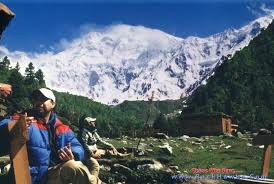
(Credit rockhawks.com)
ISLAMABAD May 4: Gunmen shot dead 10 foreign tourists at its base camp last year, but for serious mountaineers, the allure of Pakistan’s “killer mountain” remains irresistible.
Militants stormed Nanga Parbat base camp on the night of June 22, 2013, dragging the climbers out of their tents and shooting them point blank along with their local guide.
The massacre badly hit tourism in Pakistan’s wild, mountainous north, which is home to some of the world’s highest peaks and most challenging climbs.
But three winter summit attempts have brought fresh hopes for the industry, crucial to the local economy, as it gears up for the summer climbing season.
Nanga Parbat, Pakistan’s second-highest peak at 8,125 metres (26,660 feet), has never been climbed successfully in winter because of the treacherous weather conditions.
Its fearsome Rupal Face, rising more than 4,000 metres from base to top, presents one of the most difficult — and tantalising — challenges in climbing.
Simone Moro, one of the world’s leading Alpinists, was among those to return unsuccessful from Nanga Parbat this winter.
The Italian has now made two attempts to climb the peak in winter and the mountain is drawing him to make a third.
“I have felt strange feelings there, feelings that I have never felt before at the foot of a mountain,” he said.
“Nanga is not just a mountain, it is a whole world on its own to be discovered and explored — a planet apart from the Himalayas.”
“The Rupal Face is incredible, its like a giant planet standing in front of you, seducing you to climb it.”
Nanga Parbat earned its grisly nickname after more than 30 climbers died trying to conquer it before the first successful summit in 1953.
The events of last June gave the name a new, more sinister overtone but Moro says the incident was a blip and he wants to encourage others to come to Pakistan.
“I consider Nanga Parbat as the most safest place in Pakistan,” he said.
“What happened last year was just a tragic episode, accidents can happen anywhere in the world but that never means it will always repeat itself.”
David Goettler, a German member of the expedition led by Moro who has twice attempted K2 — Pakistan’s highest peak and the world’s second-highest — said he was astonished by the attack.
“I could not believe it, I was like ‘how on earth did the terrorists come there?’” he said.
“I have visited Pakistan six times in the past and I have a super good relationship with the people there.”
The regional government in Gilgit-Baltistan has slashed the fee for climbing in winter by 95 percent to $270.
But Moro said it was very difficult for mountaineers to get visas for Pakistan — a common gripe from tourists who face seemingly endless bureaucratic hurdles to visit even for a short time.
“You have to literally fight for six to seven months to get a visa for Pakistan — you need to open your doors in order to let people come in,” said Moro.
Ashraf Aman, the first Pakistani climber to scale K2, says the government is making no serious effort to encourage tourism.
The country’s powerful intelligence services — which keep a close watch on foreigners travelling outside of major cities — make life difficult for those who do arrive, said Aman, who now runs a tour operating company.
“It is very difficult to get a visa and if a tourist’s luck wins him a visa he regrets his decision the moment he arrives in Pakistan,” he said.
“The security and intelligence agencies start never-ending sessions of questions, one after another at each destination.”
Nestled between the western end of the Himalayas, the Hindu Kush mountains and the Karakoram range, Gilgit-Baltistan houses 18 of the world’s 50 highest peaks.
It is also home to three of the world’s seven longest glaciers outside the polar regions and hundreds of its mountains have never been climbed.
But it is the lure of Nanga Parbat that draws Moro back, the famous names that have climbed it in the past — Reinhold Messner, Steve House, Tomaz Humar.
“Climbing Nanga Parbat is like crossing an ocean or a desert, heading to the peak with the idea of joining two points across a treacherous nowhere,” said Moro.
